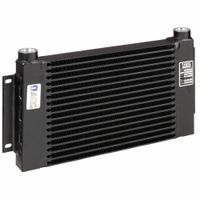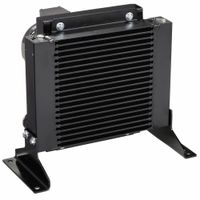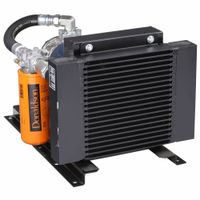Call +(254) 703 030 000 / 751 483 999 / 721 704 777
- Home
- Hydraulics
- Hydraulic Oil Coolers
.....Read More
Frequently Asked Questions
What is the purpose of a hydraulic oil cooler?
A hydraulic oil cooler is a critical component in hydraulic systems designed to dissipate excess heat generated during operation. Hydraulic fluid, under pressure and motion, experiences friction and energy conversion, leading to a rise in its temperature. Without proper cooling, elevated oil temperatures can cause a cascade of detrimental effects, including reduced fluid viscosity, accelerated wear of pumps and valves, degradation of seals and hoses, and ultimately, system inefficiency and premature component failure.
The primary purpose of a hydraulic oil cooler is to maintain the oil within its optimal operating temperature range. This is achieved by transferring heat from the hot hydraulic oil to a cooler medium, typically air or water. By keeping the oil cool, the cooler helps preserve the fluid's lubricating properties, ensuring smooth and efficient operation of hydraulic components. It also prevents thermal degradation of the oil, extending its service life and reducing maintenance costs. In essence, a hydraulic oil cooler safeguards the integrity and performance of the entire hydraulic system, contributing to its longevity and reliability.
How does a hydraulic oil cooler work?
A hydraulic oil cooler is a crucial component in hydraulic systems, designed to dissipate excess heat generated during operation. This heat can arise from various sources, including friction within the fluid, energy losses across pumps and valves, and external environmental factors. Elevated oil temperatures can degrade the hydraulic fluid, reduce its viscosity, and ultimately lead to premature wear of system components and decreased efficiency.
The fundamental principle of a hydraulic oil cooler involves transferring heat from the hot hydraulic oil to a cooler medium, typically air or water. In air-cooled systems, a fan blows ambient air over a heat exchanger (often a finned tube assembly) through which the hot hydraulic oil flows. The heat from the oil is transferred to the cooler air and then expelled. In water-cooled systems, the hot hydraulic oil passes through a heat exchanger where it comes into indirect contact with a continuous flow of cooler water. The heat is transferred from the oil to the water, which then carries the heat away. The design of the heat exchanger, whether plate, shell and tube, or finned coil, maximizes the surface area for efficient heat transfer. By maintaining the hydraulic oil within an optimal temperature range, the cooler helps preserve the integrity and performance of the hydraulic system, extending the lifespan of its components and ensuring smooth operation.
What are the differences between air and water hydraulic oil coolers?
Air hydraulic oil coolers use ambient air to dissipate heat from hydraulic oil, often employing fins and fans to maximize surface area and airflow. They are generally simpler, less expensive to install, and ideal for applications where water is scarce or expensive, or where a dedicated water source is inconvenient. However, their cooling efficiency is directly dependent on the ambient air temperature, making them less effective in hot environments.
Water hydraulic oil coolers, on the other hand, use a continuous flow of water to transfer heat away from the hydraulic oil. These coolers are typically more efficient, especially in high heat load applications or environments with high ambient air temperatures, as water has a higher thermal conductivity than air. They are often more compact for a given cooling capacity and can maintain more consistent oil temperatures. The downsides include the need for a water source, potential for water quality issues (corrosion, scaling), and higher installation costs due to plumbing requirements. The choice between the two depends on factors like heat load, available space, environmental conditions, and budget.
How do I choose the right hydraulic oil cooler for my system?
Choosing the right hydraulic oil cooler for your system involves considering several key factors to ensure optimal performance and longevity.
First, determine the required cooling capacity. This depends on the heat generated by your hydraulic system, which can be calculated based on the system's power consumption and efficiency. Factors like operating pressure, flow rate, and duty cycle also contribute to heat generation.
Second, consider the type of cooler. Air-cooled coolers are common and efficient for many applications, using ambient air to dissipate heat. Water-cooled coolers offer higher cooling capacity in a smaller footprint, often used when space is limited or a consistent water supply is available. Plate heat exchangers are another option, providing excellent heat transfer efficiency.
Third, assess the operating environment. Extreme temperatures, dust, and corrosive elements can impact cooler performance and lifespan. Choose a cooler with appropriate materials and construction for the environment.
Fourth, match the cooler to your system's flow rate and pressure requirements. Ensure the cooler can handle the maximum flow and pressure without excessive pressure drop, which can reduce system efficiency.
Finally, consider mounting options and space availability. Coolers come in various configurations, including in-tank, off-line, and in-line, each with different space requirements and installation procedures.
What are the benefits of using a hydraulic oil cooler?
A hydraulic oil cooler is a crucial component in hydraulic systems, designed to dissipate excess heat generated during operation. The primary benefits of using a hydraulic oil cooler include:1. Extended Component Life: By maintaining optimal oil temperatures, a cooler prevents thermal degradation of hydraulic fluids, seals, hoses, and other components. This reduces wear and tear, leading to a longer lifespan for the entire hydraulic system.
2. Improved System Efficiency: Overheated hydraulic fluid becomes less viscous, leading to reduced lubrication, increased internal leakage, and decreased power transmission efficiency. An oil cooler ensures the fluid maintains its proper viscosity, maximizing the system's performance and minimizing energy waste.
3. Reduced Maintenance Costs: Preventing overheating minimizes the risk of component failures and unscheduled downtime. This leads to fewer repairs, lower replacement costs, and overall reduced maintenance expenses.
4. Enhanced Operator Safety: Excessive heat can pose safety risks by potentially causing burns or creating a fire hazard. A cooler helps maintain a safer operating environment by keeping fluid temperatures within acceptable limits.
5. Consistent Performance: In applications where continuous operation is critical, maintaining stable oil temperatures ensures consistent and reliable system performance, preventing fluctuations in pressure and flow that can occur with varying fluid temperatures.In summary, a hydraulic oil cooler is an investment that pays off by safeguarding the hydraulic system, optimizing its performance, and reducing operational costs.
How do I maintain a hydraulic oil cooler?
Maintaining a hydraulic oil cooler is crucial for the efficiency and longevity of hydraulic systems. Regular maintenance involves several key steps. First, regularly inspect the cooler for any signs of leaks, damage, or corrosion on the fins and tubes. Dirt and debris can accumulate on the cooling fins, reducing heat transfer efficiency, so cleaning them periodically with compressed air or a soft brush is essential. For more stubborn grime, a degreaser can be used, ensuring it's compatible with the cooler's materials.
It's also important to check the oil level and quality in the hydraulic system, as contaminated or low oil levels can overwork the cooler. Replace filters as recommended by the manufacturer to prevent contaminants from circulating. Monitor the operating temperature of the hydraulic system; consistently high temperatures can indicate a problem with the cooler or the system itself. Finally, ensure proper airflow around the cooler and verify that any fans or pumps associated with the cooling system are functioning correctly. Adhering to a preventative maintenance schedule will help avoid costly breakdowns and ensure optimal performance.
What are common problems with hydraulic oil coolers and how can they be fixed?
Common problems with hydraulic oil coolers include: * **Clogging:** Debris, sludge, or oxidation byproducts can restrict fluid flow, reducing cooling efficiency. This often manifests as elevated oil temperatures. Regular fluid filtration and adherence to recommended oil change intervals can prevent clogging. For existing clogs, a professional flush or chemical cleaning may be necessary.
* **Leaks:** Damaged seals, fittings, or cracks in the cooler core can lead to oil leaks. Leaks reduce the system's oil volume and can introduce contaminants. Identifying the source of the leak and replacing the faulty component (e.g., O-rings, hoses, or the cooler itself) is the primary fix.
* **Corrosion:** Water ingress or acidic oil can cause internal corrosion, leading to material degradation and potential leaks. Using high-quality hydraulic oil with appropriate additives and preventing water contamination are crucial preventive measures. Once corrosion is significant, cooler replacement is often the only solution.
* **Fouling (External):** Dust, dirt, and other airborne contaminants can accumulate on the external fins of air-to-oil coolers, acting as an insulating layer and hindering heat dissipation. Regular cleaning of the cooler's exterior with compressed air or a suitable cleaner can resolve this.
* **Over-pressurization:** Excessive pressure in the hydraulic system can stress the cooler, leading to leaks or rupture. Ensuring that the system's relief valves are functioning correctly and that the operating pressure is within the cooler's design limits is important.
* **Incorrect Sizing:** An undersized cooler will struggle to dissipate heat effectively, leading to consistent overheating. An oversized cooler may cause the oil to run too cool, which can also be detrimental to the system. Proper cooler sizing based on system heat load is critical during design or when upgrading.Addressing these issues typically involves routine maintenance, monitoring oil quality, and prompt repair or replacement of damaged components.
How do I install a hydraulic oil cooler?
Installing a hydraulic oil cooler involves several key steps to ensure efficient operation and prevent system damage. First, ensure the hydraulic system is de-energized and depressurized. Drain a sufficient amount of hydraulic fluid to accommodate the cooler's volume and prevent spills. Next, select an appropriate mounting location for the cooler, ideally in an area with good airflow and away from excessive heat sources. Secure the cooler firmly using mounting brackets.
Once mounted, connect the hydraulic lines. Typically, the cooler is installed in the return line of the hydraulic system, after the system's working components and before the reservoir. This allows the cooler to remove heat from the oil after it has performed its work. Use appropriate fittings and hoses, ensuring they are compatible with the hydraulic fluid and pressure. Pay close attention to the flow direction indicated on the cooler.
After connecting the lines, slowly refill the hydraulic system with the correct type and amount of hydraulic fluid. Bleed the system to remove any trapped air, which can cause erratic operation and cavitation. This usually involves cycling the hydraulic components and loosening fittings slightly to allow air to escape. Finally, start the hydraulic system and monitor for leaks and proper cooler operation. Check the oil temperature to confirm that the cooler is effectively dissipating heat. Regularly inspect connections and maintain fluid levels to ensure the longevity of the hydraulic system.
What are the signs that a hydraulic oil cooler is failing?
The signs that a hydraulic oil cooler is failing include: * **Elevated hydraulic fluid temperature:** This is often the most obvious sign. If the fluid temperature is consistently higher than normal operating ranges, the cooler may not be dissipating heat effectively.
* **Reduced cooling fan operation:** If the cooler has a fan, check if it's running continuously or not at all. A malfunctioning fan motor or electrical issue can prevent proper cooling.
* **Leaks:** Visible leaks around the cooler, hoses, or connections indicate a breach in the system, leading to fluid loss and reduced cooling efficiency.
* **Contamination:** If the hydraulic fluid appears discolored, cloudy, or has a burnt smell, it could indicate overheating and degradation, possibly due to a failing cooler allowing excessive heat to remain in the system.
* **Decreased system performance:** Overheating can lead to a drop in hydraulic system efficiency, including slower operation, reduced power, or erratic movements of machinery.
* **Abnormal noises:** Whining or grinding noises from the cooler or associated pump could indicate internal damage or component failure within the cooling system.
* **Clogged fins or tubes:** Over time, dirt, debris, or sludge can accumulate on the cooler's fins or inside its tubes, restricting airflow or fluid flow and hindering heat transfer. Regular inspection and cleaning can prevent this.
How does ambient temperature affect the performance of a hydraulic oil cooler?
Ambient temperature significantly impacts the performance of a hydraulic oil cooler. When the ambient temperature is high, the temperature difference between the hydraulic oil and the surrounding air decreases. This reduced temperature gradient makes it harder for the cooler to dissipate heat effectively from the oil, leading to an increase in oil temperature. Conversely, lower ambient temperatures create a larger temperature difference, allowing the cooler to remove heat more efficiently and maintain the oil at a more optimal operating temperature. Prolonged exposure to high oil temperatures can degrade the hydraulic fluid, reduce the lifespan of components, and decrease system efficiency. Therefore, proper sizing and design of the oil cooler, considering the expected range of ambient temperatures, are crucial for optimal hydraulic system performance and longevity.


